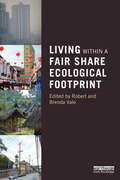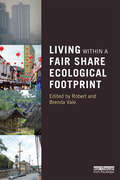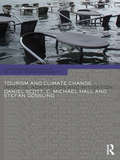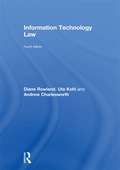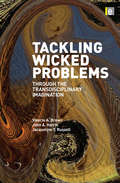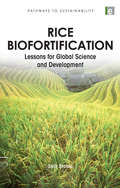- Table View
- List View
Further Mechanics
by David Bowles Eddie Mullan David Baker Brian Jefferson John Rayneau Mark Rowland Robert Wagner Paul Williams Garry Wiseman Katie Wood Mike HeylingsThis Student Book provides full support for the Further Mechanics 1 paper in the Edexcel AS and A Level exams. Throughout the book, the explanations are clear and concise, with an emphasis on visual presentation, abundant worked examples and learning by doing. In every chapter, sequential exercises allow students to practise first their fluency and skills, and then the new exam-style problem-solving and modelling questions. The problem-solving is supported byStrategy boxes, which provide guidance on how best to approach these questions. Short answers are given in the back, while full step-by-step solutions to every single question can be found online. ThisStudent Book belongs to a series of 10 OUP Student Books covering all the compulsory and optional papers for Edexcel Further Maths AS and A Level.
Applied Principles of Horticultural Science
by Laurie BrownApplied Principles of Horticultural Science is that critical thing for all students of horticulture - a book that teaches the theory of horticultural science through the practice of horticulture itelf.The book is divided into three sections - Plant science, Soil science, Pest and disease. Each section contains a number of chapters relating to a major principle of applied horticulture. Each chapter starts with a key point summary and introduces the underpinning knowledge which is then reinforced by exercises. The book contains over 70 practical exercises, presented in a way that makes students think for themselves. Answers to the exercises are given at the end of chapters. Clear step-by-step instructions make practical work accessible to students of all abilities.This new third edition provides an even wider sweep of case studies to make this book an essential practical workbook for horticulture students and gardners alike. Updated material fits with the latest RHS, City and Guilds and Edexcel syllabus. It is particularly suitable for the RHS Certificate, Advanced Certificate and Edexcel Diplomas as well as for those undertaking NPTC National, Advanced National courses and Horticulture NVQs at levels 2 and 3, together with the new Diploma in Environmental and Land-based studies.Laurie Brown is a horticultural scientist and educator. He is Director of Academex, a consultancy company aspiring to excellence in teaching and learning. Laurie previously worked with the Standards Unit on the design of exemplary teaching resources in the land-based sector.
Applied Principles of Horticultural Science
by Laurie BrownApplied Principles of Horticultural Science is that critical thing for all students of horticulture - a book that teaches the theory of horticultural science through the practice of horticulture itelf.The book is divided into three sections - Plant science, Soil science, Pest and disease. Each section contains a number of chapters relating to a major principle of applied horticulture. Each chapter starts with a key point summary and introduces the underpinning knowledge which is then reinforced by exercises. The book contains over 70 practical exercises, presented in a way that makes students think for themselves. Answers to the exercises are given at the end of chapters. Clear step-by-step instructions make practical work accessible to students of all abilities.This new third edition provides an even wider sweep of case studies to make this book an essential practical workbook for horticulture students and gardners alike. Updated material fits with the latest RHS, City and Guilds and Edexcel syllabus. It is particularly suitable for the RHS Certificate, Advanced Certificate and Edexcel Diplomas as well as for those undertaking NPTC National, Advanced National courses and Horticulture NVQs at levels 2 and 3, together with the new Diploma in Environmental and Land-based studies.Laurie Brown is a horticultural scientist and educator. He is Director of Academex, a consultancy company aspiring to excellence in teaching and learning. Laurie previously worked with the Standards Unit on the design of exemplary teaching resources in the land-based sector.
Living within a Fair Share Ecological Footprint
by Robert Vale Brenda ValeAccording to many authorities the impact of humanity on the earth is already overshooting the earth’s capacity to supply humanity’s needs. This is an unsustainable position. This book does not focus on the problem but on the solution, by showing what it is like to live within a fair earth share ecological footprint. The authors describe numerical methods used to calculate this, concentrating on low or no cost behaviour change, rather than on potentially expensive technological innovation. They show what people need to do now in regions where their current lifestyle means they are living beyond their ecological means, such as in Europe, North America and Australasia. The calculations focus on outcomes rather than on detailed discussion of the methods used. The main objective is to show that living with a reduced ecological footprint is both possible and not so very different from the way most people currently live in the west. The book clearly demonstrates that change in behaviour now will avoid some very challenging problems in the future. The emphasis is on workable, practical and sustainable solutions based on quantified research, rather than on generalities about overall problems facing humanity.
Living within a Fair Share Ecological Footprint
by Robert Vale Brenda ValeAccording to many authorities the impact of humanity on the earth is already overshooting the earth’s capacity to supply humanity’s needs. This is an unsustainable position. This book does not focus on the problem but on the solution, by showing what it is like to live within a fair earth share ecological footprint. The authors describe numerical methods used to calculate this, concentrating on low or no cost behaviour change, rather than on potentially expensive technological innovation. They show what people need to do now in regions where their current lifestyle means they are living beyond their ecological means, such as in Europe, North America and Australasia. The calculations focus on outcomes rather than on detailed discussion of the methods used. The main objective is to show that living with a reduced ecological footprint is both possible and not so very different from the way most people currently live in the west. The book clearly demonstrates that change in behaviour now will avoid some very challenging problems in the future. The emphasis is on workable, practical and sustainable solutions based on quantified research, rather than on generalities about overall problems facing humanity.
Marine Biodiversity, Climatic Variability and Global Change
by Grégory BeaugrandBiodiversity loss in terrestrial environments associated with human activities has been appreciated as a major issue for some years now. What is less well documented is the effect of such activities, including climate change, on marine biodiversity. This pioneering book is the first to address this important but neglected topic, which is likely to be the key challenge for marine scientists in the near future. Using a multidisciplinary and a holistic approach, the book reveals how climatic variability controls biodiversity at time scales ranging from synoptic meteorological events to millions of years and at spatial scales ranging from local sites to the whole ocean. It shows how global change, including anthropogenic climate change, ocean acidification and more direct human influences such as exploitation, pollution and eutrophication may alter biodiversity, ecosystem functioning and regulating and provisioning services. The author proposes a theory termed the 'macroecological theory on the arrangement of life', which explains how biodiversity is organized and how it responds to climatic variability and anthropogenic climate change. The book concludes with recommendations for further research and theoretical development to identify oceanic areas in need of observation and gaps in current scientific knowledge. Many references and comparisons with the terrestrial realm are included in all chapters to better understand the universality of the relationships between biodiversity, climate and the environment. The book will serve as a textbook for all students and researchers of marine science and environmental change, but will also be accessible to the more general reader.
Marine Biodiversity, Climatic Variability and Global Change
by Grégory BeaugrandBiodiversity loss in terrestrial environments associated with human activities has been appreciated as a major issue for some years now. What is less well documented is the effect of such activities, including climate change, on marine biodiversity. This pioneering book is the first to address this important but neglected topic, which is likely to be the key challenge for marine scientists in the near future. Using a multidisciplinary and a holistic approach, the book reveals how climatic variability controls biodiversity at time scales ranging from synoptic meteorological events to millions of years and at spatial scales ranging from local sites to the whole ocean. It shows how global change, including anthropogenic climate change, ocean acidification and more direct human influences such as exploitation, pollution and eutrophication may alter biodiversity, ecosystem functioning and regulating and provisioning services. The author proposes a theory termed the 'macroecological theory on the arrangement of life', which explains how biodiversity is organized and how it responds to climatic variability and anthropogenic climate change. The book concludes with recommendations for further research and theoretical development to identify oceanic areas in need of observation and gaps in current scientific knowledge. Many references and comparisons with the terrestrial realm are included in all chapters to better understand the universality of the relationships between biodiversity, climate and the environment. The book will serve as a textbook for all students and researchers of marine science and environmental change, but will also be accessible to the more general reader.
Tourism and Climate Change: Impacts, Adaptation and Mitigation
by Daniel Scott C. Michael Hall Gossling StefanClimate change is the single most important global environmental and development issue facing the world today and has emerged as a major topic in tourism studies. Climate change is already affecting the tourism industry and is anticipated to have profound implications for tourism in the twenty-first century, including consumer holiday choices, the geographic patterns of tourism demand, the competitiveness and sustainability of destinations and the contribution of tourism to international development. Tourism and Climate Change: Impacts, Adaptation and Mitigation is the first book to provide a comprehensive overview of the theory and practice of climate change and tourism at the tourist, enterprise, destination and global scales. Major themes include the implications of climate change and climate policy for tourism sectors and destinations around the world, tourist perceptions of climate change impacts, tourism’s global contribution to climate change, adaptation and mitigation responses by all major tourism stakeholders, and the integral links between climate change and sustainable tourism. It combines a thorough scientific assessment of the climate-tourism interrelationships with discussion of emerging mitigation and adaptation practice, showcasing international examples throughout the tourism sector as well as actions by other sectors that will have important implications for tourism. Written by three leading academics in this field, this critical contribution highlights the challenges of climate change within the tourism community and provides a foundation for decision making for both reducing the risks, and taking advantage of the opportunities, associated with climate change. This comprehensive discussion of the complexities of climate change and tourism is essential reading for students, academics, business leaders and government policy makers.
Tourism and Climate Change: Impacts, Adaptation and Mitigation
by Daniel Scott C. Michael Hall Gossling StefanClimate change is the single most important global environmental and development issue facing the world today and has emerged as a major topic in tourism studies. Climate change is already affecting the tourism industry and is anticipated to have profound implications for tourism in the twenty-first century, including consumer holiday choices, the geographic patterns of tourism demand, the competitiveness and sustainability of destinations and the contribution of tourism to international development. Tourism and Climate Change: Impacts, Adaptation and Mitigation is the first book to provide a comprehensive overview of the theory and practice of climate change and tourism at the tourist, enterprise, destination and global scales. Major themes include the implications of climate change and climate policy for tourism sectors and destinations around the world, tourist perceptions of climate change impacts, tourism’s global contribution to climate change, adaptation and mitigation responses by all major tourism stakeholders, and the integral links between climate change and sustainable tourism. It combines a thorough scientific assessment of the climate-tourism interrelationships with discussion of emerging mitigation and adaptation practice, showcasing international examples throughout the tourism sector as well as actions by other sectors that will have important implications for tourism. Written by three leading academics in this field, this critical contribution highlights the challenges of climate change within the tourism community and provides a foundation for decision making for both reducing the risks, and taking advantage of the opportunities, associated with climate change. This comprehensive discussion of the complexities of climate change and tourism is essential reading for students, academics, business leaders and government policy makers.
Leading the Sustainable Organization: Development, Implementation and Assessment
by J. Lee Whittington Tim Galpin Greg BellThis book is the first to combine the much talked about topics of leadership and sustainability, and provides readers with a comprehensive overview and pragmatic approach to leading sustainable organizations. Chapters include discussions, case examples, steps, and useful tools centred on the components of the Leading the Sustainable Organization model. This model provides managers with a pragmatic, end-to-end framework for creating (in the case of new entities) or shifting (in the case of existing firms) their organizations’ workforces to a sustainability focus. Leading the Sustainable Organization is the perfect tool for executives and managers in small, medium, and large companies, and in all industries, to assist with the difficult and confusing topic of leading sustainability efforts. This book will be of great interest to students and academics who want to learn more about corporate sustainability.
Talking Heads: The Neuroscience of Language
by Gianfranco DenesThe origin, development, and nature of language has been the focus of theoretical debate among philosophers for many centuries. Following the pioneering clinical observations 150 years ago of loss of language following a cerebral lesion, language started to be considered a biological system, that could be investigated scientifically. As a consequence, an increasing number of scientists began to search for its anatomical and functional basis and its links with other such cognitive systems. The relatively recent introduction of neuroimaging tools, such as PET and fMRI, has brought rapid and groundbreaking developments to the field of Neurolinguistics. In this book, Denes harnesses these advances to adopt a biolinguistic approach to the study of a subject that increasingly sees the collaboration of linguists, experimental psychologists, neuroscientists and clinicians. Talking Heads reviews the latest research to provide a concise analysis of the multifaceted aspects of language which focuses both on theoretical aspects and physical implementation. Following an up-to-date description of acquired language disorders, and their contribution to the design of a functional architecture of language, the book illustrates the neurological process involved in the production and comprehension of spoken and written language, as well as investigating the neurological and functional systems responsible for sign language production and first and second language acquisition. With a glossary of the anatomical and linguistic terms, this book provides an invaluable resource to undergraduate and graduate students of psychology, psycholinguistics and linguistics.
Talking Heads: The Neuroscience of Language
by Gianfranco DenesThe origin, development, and nature of language has been the focus of theoretical debate among philosophers for many centuries. Following the pioneering clinical observations 150 years ago of loss of language following a cerebral lesion, language started to be considered a biological system, that could be investigated scientifically. As a consequence, an increasing number of scientists began to search for its anatomical and functional basis and its links with other such cognitive systems. The relatively recent introduction of neuroimaging tools, such as PET and fMRI, has brought rapid and groundbreaking developments to the field of Neurolinguistics. In this book, Denes harnesses these advances to adopt a biolinguistic approach to the study of a subject that increasingly sees the collaboration of linguists, experimental psychologists, neuroscientists and clinicians. Talking Heads reviews the latest research to provide a concise analysis of the multifaceted aspects of language which focuses both on theoretical aspects and physical implementation. Following an up-to-date description of acquired language disorders, and their contribution to the design of a functional architecture of language, the book illustrates the neurological process involved in the production and comprehension of spoken and written language, as well as investigating the neurological and functional systems responsible for sign language production and first and second language acquisition. With a glossary of the anatomical and linguistic terms, this book provides an invaluable resource to undergraduate and graduate students of psychology, psycholinguistics and linguistics.
Urban Ecosystems: Understanding the Human Environment
by Robert A. Francis Michael A. ChadwickWith over half of the global human population living in urban regions, urban ecosystems may now represent the contemporary and future human environment. Consisting of green space and the built environment, they harbour a wide range of species, yet are not well understood. This book aims to review what is currently known about urban ecosystems in a short and approachable text that will serve as a key resource for teaching and learning related to the urban environment. It covers both physical and biotic components of urban ecosystems, key ecological processes, and the management of ecological resources, including biodiversity conservation. All chapters incorporate case studies, boxes and questions for stimulating discussions in the learning environment.
Urban Ecosystems: Understanding the Human Environment
by Robert A. Francis Michael A. ChadwickWith over half of the global human population living in urban regions, urban ecosystems may now represent the contemporary and future human environment. Consisting of green space and the built environment, they harbour a wide range of species, yet are not well understood. This book aims to review what is currently known about urban ecosystems in a short and approachable text that will serve as a key resource for teaching and learning related to the urban environment. It covers both physical and biotic components of urban ecosystems, key ecological processes, and the management of ecological resources, including biodiversity conservation. All chapters incorporate case studies, boxes and questions for stimulating discussions in the learning environment.
Information Technology Law
by Diane Rowland Uta Kohl Andrew CharlesworthThis fourth edition of Information Technology Law has been completely revised in the light of developments within the field since publication of the first edition in 1997. Now dedicated to a more detailed analysis of and commentary on the latest developments within this burgeoning field of law, this new edition is an essential read for all those interested in the interface between law and technology and the effect of new technological developments on the law. New additions to the fourth edition include: analysis of regulatory issues and jurisdictional questions specific consideration of intermediary liability developments in privacy and data protection extension of computer crime laws developments in software patents open source software and the legal implications.
Information Technology Law
by Diane Rowland Uta Kohl Andrew CharlesworthThis fourth edition of Information Technology Law has been completely revised in the light of developments within the field since publication of the first edition in 1997. Now dedicated to a more detailed analysis of and commentary on the latest developments within this burgeoning field of law, this new edition is an essential read for all those interested in the interface between law and technology and the effect of new technological developments on the law. New additions to the fourth edition include: analysis of regulatory issues and jurisdictional questions specific consideration of intermediary liability developments in privacy and data protection extension of computer crime laws developments in software patents open source software and the legal implications.
Not Here, Not There, Not Anywhere: Politics, Social Movements, and the Disposal of Low-Level Radioactive Waste
by Daniel J. ShermanIn 1979, provoked by the Three Mile Island nuclear accident, governors of states hosting disposal facilities for low-level radioactive waste (LLRW) refused to accept additional shipments. The resulting shortage of disposal sites for wastes spurred Congress to devolve responsibility for establishing new, geographically diffuse LLRW disposal sites to states and regional compacts, with siting authorities often employing socio-economic and political data to target communities that would give little resistance to their plans. The communities, however, were far from compliant, organizing nearly 1000 opposition events that ended up blocking the implementation of any new disposal sites. Sherman provides comprehensive coverage of this opposition, testing hypotheses regarding movement mobilization and opposition strategy by analyzing the frequency and disruptive qualities of activism. In the process, he bridges applied policy questions about hazardous waste disposal with broader questions about the dynamics of social movements and the intergovernmental politics of policy implementation. The issues raised in this book are sure to be renewed as interest grows in nuclear power and the disposal of the resulting waste remains uncertain.
Not Here, Not There, Not Anywhere: Politics, Social Movements, and the Disposal of Low-Level Radioactive Waste
by Daniel J. ShermanIn 1979, provoked by the Three Mile Island nuclear accident, governors of states hosting disposal facilities for low-level radioactive waste (LLRW) refused to accept additional shipments. The resulting shortage of disposal sites for wastes spurred Congress to devolve responsibility for establishing new, geographically diffuse LLRW disposal sites to states and regional compacts, with siting authorities often employing socio-economic and political data to target communities that would give little resistance to their plans. The communities, however, were far from compliant, organizing nearly 1000 opposition events that ended up blocking the implementation of any new disposal sites. Sherman provides comprehensive coverage of this opposition, testing hypotheses regarding movement mobilization and opposition strategy by analyzing the frequency and disruptive qualities of activism. In the process, he bridges applied policy questions about hazardous waste disposal with broader questions about the dynamics of social movements and the intergovernmental politics of policy implementation. The issues raised in this book are sure to be renewed as interest grows in nuclear power and the disposal of the resulting waste remains uncertain.
Biochemistry And Molecular Biology Of Antimicrobial Drug Action (6th Edition) (PDF)
by Trevor J. Franklin George Alan SnowThe subject is one of major interest in basic microbiology and infectious diseases and the book is a known classic.
Tackling Wicked Problems: Through the Transdisciplinary Imagination
by John Harris Valerie A Brown Jacqueline RussellFrom climate change to GM foods, we are increasingly confronted with complex, interconnected social and environmental problems that span disciplines, knowledge bases and value systems. This book offers a transdisciplinary, open approach for those working towards resolving these 'wicked' problems and highlights the crucial role of this 'transdisciplinary imagination' in addressing the shift to sustainable futures. Tackling Wicked Problems provides readers with a framework and practical examples that will guide the design and conduct of their own open-ended enquiries. In this approach, academic disciplines are combined with personal, local and strategic understanding and researchers are required to recognise multiple knowledge cultures, accept the inevitability of uncertainty, and clarify their own and others' ethical positions. The authors then comment on fifteen practical examples of how researchers have engaged with the opportunities and challenges of conducting transdisciplinary inquiries. The book gives those who are grappling with complex problems innovative methods of inquiry that will allow them to work collaboratively towards long-term solutions.
Tackling Wicked Problems: Through the Transdisciplinary Imagination
by John Harris Valerie A Brown Jacqueline RussellFrom climate change to GM foods, we are increasingly confronted with complex, interconnected social and environmental problems that span disciplines, knowledge bases and value systems. This book offers a transdisciplinary, open approach for those working towards resolving these 'wicked' problems and highlights the crucial role of this 'transdisciplinary imagination' in addressing the shift to sustainable futures. Tackling Wicked Problems provides readers with a framework and practical examples that will guide the design and conduct of their own open-ended enquiries. In this approach, academic disciplines are combined with personal, local and strategic understanding and researchers are required to recognise multiple knowledge cultures, accept the inevitability of uncertainty, and clarify their own and others' ethical positions. The authors then comment on fifteen practical examples of how researchers have engaged with the opportunities and challenges of conducting transdisciplinary inquiries. The book gives those who are grappling with complex problems innovative methods of inquiry that will allow them to work collaboratively towards long-term solutions.
Rice Biofortification: Lessons for Global Science and Development
by Sally BrooksBiofortification - the enrichment of staple food crops with essential micronutrients - has been heralded as a uniquely sustainable solution to the problem of micronutrient deficiency or 'hidden hunger'. Considerable attention and resources are being directed towards the biofortification of rice - the world's most important food crop. Through an in-depth analysis of international rice biofortification efforts across the US, Philippines and China, this book provides an important critique of such goal-oriented, top-down approaches. These approaches, the author argues, exemplify a model of global, 'public goods' science that is emerging within complex, international research networks. It provides vital lessons for those researching and making decisions about science and research policy, showing that if this model becomes entrenched, it is likely to channel resources towards the search for 'silver bullet' solutions at the expense of more incremental approaches that respond to locality, diversity and the complex and uncertain interactions between people and their environments. The author proposes a series of key changes to institutions and practices that might allow more context-responsive alternatives to emerge. These issues are particularly important now as increasing concerns over food security are leading donors and policy makers to commit to ambitious visions of 'impact at scale' - visions which may never become a reality and may preclude more effective pathways from being pursued. Published in association with the Economic and Social Research Council (ESRC)
Rice Biofortification: Lessons for Global Science and Development
by Sally BrooksBiofortification - the enrichment of staple food crops with essential micronutrients - has been heralded as a uniquely sustainable solution to the problem of micronutrient deficiency or 'hidden hunger'. Considerable attention and resources are being directed towards the biofortification of rice - the world's most important food crop. Through an in-depth analysis of international rice biofortification efforts across the US, Philippines and China, this book provides an important critique of such goal-oriented, top-down approaches. These approaches, the author argues, exemplify a model of global, 'public goods' science that is emerging within complex, international research networks. It provides vital lessons for those researching and making decisions about science and research policy, showing that if this model becomes entrenched, it is likely to channel resources towards the search for 'silver bullet' solutions at the expense of more incremental approaches that respond to locality, diversity and the complex and uncertain interactions between people and their environments. The author proposes a series of key changes to institutions and practices that might allow more context-responsive alternatives to emerge. These issues are particularly important now as increasing concerns over food security are leading donors and policy makers to commit to ambitious visions of 'impact at scale' - visions which may never become a reality and may preclude more effective pathways from being pursued. Published in association with the Economic and Social Research Council (ESRC)
Ocean Zoning: Making Marine Management More Effective
by Tundi S. AgardyOur knowledge of the oceans is increasing rapidly, as more powerful tools for exploration and exploitation make it easier to locate valuable resources, such as fish stocks, oil and gas reserves, or sites for wind and hydropower schemes. At the same time competition for space has intensified, affecting marine life and people's livelihoods. Much has been written about marine management using marine protected areas, but MPAs are only a small subset of spatial management tools available. MPAs and MPA networks are better seen as starting points for more comprehensive spatial management, facilitated by ocean zoning. This logical scaling up from discreet piecemeal protected areas to larger and more systematic planning is happening around the world, but few are aware that we are entering a brave new world in ocean management with zoning at its core. This book provides guidance on using ocean zoning to improve marine management. It reviews the benefits of ocean zoning in theory, reviews progress made in zoning around the world through a wide range of case studies, and derives lessons learned to recommend a process by which future zoning can be maximally effective and efficient. Published with MARES, Forest Trends and UNEP
Ocean Zoning: Making Marine Management More Effective
by Tundi S. AgardyOur knowledge of the oceans is increasing rapidly, as more powerful tools for exploration and exploitation make it easier to locate valuable resources, such as fish stocks, oil and gas reserves, or sites for wind and hydropower schemes. At the same time competition for space has intensified, affecting marine life and people's livelihoods. Much has been written about marine management using marine protected areas, but MPAs are only a small subset of spatial management tools available. MPAs and MPA networks are better seen as starting points for more comprehensive spatial management, facilitated by ocean zoning. This logical scaling up from discreet piecemeal protected areas to larger and more systematic planning is happening around the world, but few are aware that we are entering a brave new world in ocean management with zoning at its core. This book provides guidance on using ocean zoning to improve marine management. It reviews the benefits of ocean zoning in theory, reviews progress made in zoning around the world through a wide range of case studies, and derives lessons learned to recommend a process by which future zoning can be maximally effective and efficient. Published with MARES, Forest Trends and UNEP


